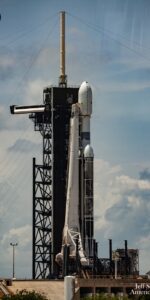
After a dramatic scrub at T-16 seconds on Wednesday morning, SpaceX successfully launched its third Falcon 9 mission of April out of Vandenberg Space Force Base, Calif., early Thursday. The veteran B1061 core—which previously flew 12 times between November 2020 and last month—was seemingly stricken with cruel luck yesterday as she aimed for her 13th launch and 2023’s 13th batch of Starlink low-orbiting internet communications satellites.
Citing a “probability of landing failure” as the cause of Wednesday’s scrub, without further elaboration, SpaceX oddly tweeted only a few minutes afterward that “vehicle is healthy” and that it was aiming at a backup launch attempt at 6:40 a.m. PDT (9:40 a.m. EDT) the following day. Without further ado, the many-times-used booster sprang from Space Launch Complex (SLC)-4E on Thursday morning to begin SpaceX’s eighth Vandenberg flight of 2023, a record-setting third Falcon 9 mission of the month from the West Coast and B1061’s own second outing of the year.

Since January 2015, and including this morning’s launch, SpaceX has now made 155 tries to land Falcon 9 or Falcon Heavy hardware on ocean-going Autonomous Spaceport Drone Ships (ASDS), with ten outright failures, most recently the February 2021 loss of B1059. Causes ranged from hard impacts to excessive lateral velocities on final approach to the ASDS and from problems with latches in the Falcon 9’s landing legs to propellant shortfalls during the Landing Burn.
Supporting today’s launch was the West Coast-based drone ship, “Of Course I Still Love You”, which put to sea last weekend out of Port of Long Beach, bound for a recovery position some 390 miles (630 kilometers) offshore in the Pacific Ocean. After boosting the 230-foot-tall (70-meter) Falcon 9 uphill for the opening 2.5 minutes of ascent, B1061 separated cleanly from the stack and pirouetted to a picture-perfect, on-point touchdown on the ASDS deck, some 8.5 minutes after liftoff.

In wrapping up the 13th mission of her career, B1061 now sits in joint third place with her near-twin B1062 on the list of SpaceX’s most-flown boosters. And with her sisters B1058—first used to launch “Bob and Doug” in May 2020—and B1060 having both reached a record-tying 15 flights on their most recent launches in mid-December and early January, respectively, their status as active members of the Falcon 9 fleet have been paused as they have now attained the maximum amount of certified flights. It remains to be seen if either will be recertified to fly additional times, a decision which SpaceX will likely make based upon the needs of its fast-paced mission manifest.
It was SpaceX’s 20th drone ship landing of this year and its 93rd consecutive success since its most recent failure in February 2021. With B1061’s job done, the single Merlin 1D+ Vacuum engine of the Falcon 9’s second stage ignited for a standard six-minute “burn” to lift the 46-strong Starlink “stack” into low-Earth orbit.

As this AmericaSpace story was being prepared, the satellites were set to deploy at 59 minutes into the mission. And that brings the total number of Starlinks flown in 2023 to over 600.
Between May 2019 and this morning, more than 4,200 production-design Starlinks have been launched into orbit, facilitating high-speed and low-latency internet provision across more than 50 sovereign nations and international markets spanning North and South America, Europe, Asia, Oceania and Africa. In the last few weeks alone, Haiti, Ecuador and El Salvador have officially signed up to Starlink.

Today’s flight is also the first time that SpaceX has flown three Falcon 9s in a single calendar month from Vandenberg, following on the heels of the inaugural Tranche-0 of the Transport and Tracking Layer (TTL) for the Space Development Agency (SDA) at the start of April and the 51-payload Transporter-7 “rideshare” at mid-month. Added to that, a total of 299 Starlinks have headed aloft from the West Coast on a total of eight Falcon 9 launches since the beginning of the 2023.
SpaceX has been flying out of Vandenberg since September 2013 and has now launched 40 Falcon 9 missions, using only 15 boosters, one of which recently flew for its ninth time. Payloads included eight Iridium NEXT and 16 Starlink batches of low-orbiting communications satellites, a pair of highly classified missions for the National Reconnaissance Office and the NASA-led Double Asteroid Redirection Test (DART) to visit the binary asteroid 65803 Didymos and deploy a high-velocity kinetic impactor to impact its tiny companion, Dimorphos.

Last year, the Hawthorne, Calif.-headquartered organization flew its most prolific year on record out of Vandenberg, with 13 launches, a record that 2023 looks set to eclipse. SpaceX releases precious little by way of a definitive flight schedule, but there are several notable payloads heading uphill from Vandenberg in the year’s second half, including a pair of “passive” SARah reflector satellites for the German Armed Forces, a pair of Arctic Satellite Broadband Mission (ASBM) satellites and “up to five” ground-spare Iridium NEXT birds.
Currently, four boosters—B1061, B1063 B1071 and, introduced only in January, B1075—are stationed at Vandenberg. And with the final United Launch Alliance (ULA) Delta IV Heavy having vacated Space Launch Complex (SLC)-6 in September 2022, the U.S. Space Force announced earlier this week that it will lease the facility to SpaceX for future Falcon 9 and Falcon Heavy missions.

Attention now turns to the Space Coast, where Wednesday’s planned 7:29 p.m. EDT launch of a triple-barreled Falcon Heavy from historic Pad 39A at Florida’s Kennedy Space Center (KSC) was called off in response to an increasingly pessimistic weather picture. The mammoth Heavy—which for its next mission features a brand-new core and a pair of flight-proven side-boosters—is now targeting a liftoff at 7:29 p.m. EDT Thursday, at the opening of a 57-minute “launch window”.
Having undergone a customary Static Fire Test earlier this month, the Falcon Heavy was originally set to fly on 18 April, but launch was delayed an additional week, reportedly due to a need to replace at least one of its Merlin 1D+ engines. Returned to Pad 39A on Wednesday morning, plans to fly yesterday evening were called off as the chances of acceptable weather hovered around 50-50.

The mission will deliver the first of three ViaSat-3 ultra-high-capacity broadband satellites uphill for Carlsbad, Calif.-based ViaSat, Inc., co-manifested with smaller geostationary-bound payloads for Indonesia’s Pasifik Satelit Nusantara (PSN) and San Francisco, Calif.-headquartered Astranis Corp.
Due to the high-energy requirements—and a targeted orbital insertion point only 700 miles (1,100 kilometers) below its intended Geostationary Earth Orbit (GEO)—the core and the side-boosters will be expended on this mission. It will mark the first time that the Heavy has intentionally been flown in an entirely expendable configuration.

But weather is currently trending unfavorably, with barely a 20-percent chance that Mother Nature will smile on this second Falcon Heavy launch of 2023. “The forecast of a less convectively active has evaporated as all models point to much faster timing with the next feature in the series of upper-level disturbances aiding the complex interactions,” noted the 45th Weather Squadron at Patrick Space Force Base in a Thursday morning update.
“This increase has brought a dramatic shift in the forecast for today,” it added. Conditions are expected to remain about 30-percent-favorable for Friday evening’s backup attempt.






10 Comments
10 Pings & Trackbacks
Pingback:Will Mother Nature Smile or Frown on Friday’s Record-Breaking Pair of Space Coast Launches? - AmericaSpace
Pingback:SpaceX Targets Midnight Launch for 16x-Flown Falcon 9 - AmericaSpace
Pingback:SpaceX Flies April’s Third Vandenberg Mission, Watches Falcon ... - AmericaSpace - Digi90
Pingback:A Tale of Three Launch Sites: SpaceX Targets Falcon 9 Launch Tonight, Looks Ahead to Falcon Heavy & Starship Flights - AmericaSpace
Pingback:As Falcon 9 Passes Year’s 50th Flight, SpaceX Heads for 50th Vandenberg Launch - AmericaSpace
Pingback:Veteran Falcon 9 Wraps Up Busy September, As Falcon Heavy Readies for Psyche Mission Static Fire Test - AmericaSpace
Pingback:Veteran Falcon 9 Wraps Up Busy September, As Falcon Heavy Readies for Psyche Mission Static Fire Test - SPACERFIT
Pingback:Weather 20-Percent-Favorable for Tomorrow’s Psyche Launch - AmericaSpace
Pingback:“Not a Black Sabbath”: SpaceX Aims for Dual Launches Tomorrow, Psyche Up First - AmericaSpace
Pingback:“Not a Black Sabbath”: SpaceX Aims for Dual Launches Tomorrow, Psyche Up First - SPACERFIT